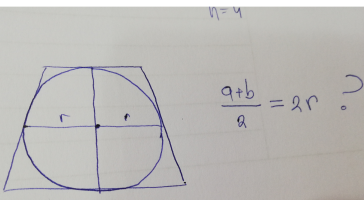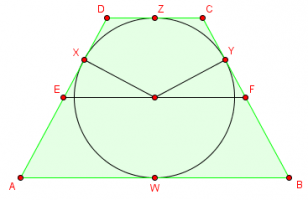You are using an out of date browser. It may not display this or other websites correctly.
You should upgrade or use an alternative browser.
You should upgrade or use an alternative browser.
Middle line trapezoid
- Thread starter Loki123
- Start date
Dr.Peterson
Elite Member
- Joined
- Nov 12, 2017
- Messages
- 16,865
The important question to ask yourself is, do you have any reason to believe that it is? In math, you can't assume anything without a reason.I am curious, say you have an isosceles trapezoid and inside it a circle. Is R (2r) the same as the middle line? Probably not because I can't seem to get the correct answer when I try that, but why isn't it the same? View attachment 30586
The "middle line" you're referring to is presumably the line joining the midpoints of the sides. Does that even look like it should be the same as the diameter of the circle? Are the ends of the diameter you show ever going to be at the midpoints of the sides?
My assumption was that the middle line is at the same distance from base 1 and base 2 and that the center of the circle would take on the same role, however, I assume, according to your explanation, the middle line does not always have to be in the middle.The important question to ask yourself is, do you have any reason to believe that it is? In math, you can't assume anything without a reason.
The "middle line" you're referring to is presumably the line joining the midpoints of the sides. Does that even look like it should be the same as the diameter of the circle? Are the ends of the diameter you show ever going to be at the midpoints of the sides?
Dr.Peterson
Elite Member
- Joined
- Nov 12, 2017
- Messages
- 16,865
No.My assumption was that the middle line is at the same distance from base 1 and base 2 and that the center of the circle would take on the same role, however, I assume, according to your explanation, the middle line does not always have to be in the middle.
Look at a careful picture:
The midline of trapezoid ABCD is EF. Does that look like a diameter? Yes, it's equidistant from AB and CD, and it does pass through the center, O. But that's why it can't equal the diameter of the circle, because E and F have to be outside the circle.
Thank you, I get itNo.
Look at a careful picture:
The midline of trapezoid ABCD is EF. Does that look like a diameter? Yes, it's equidistant from AB and CD, and it does pass through the center, O. But that's why it can't equal the diameter of the circle, because E and F have to be outside the circle.


